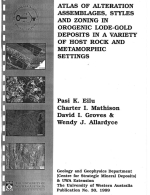Добрый день, Коллеги. Важное сообщение, просьба принять участие. Музей Ферсмана ищет помощь для реставрационных работ в помещении. Подробности по ссылке
Atlas of alteration assemblages, styles and zoning in orogenic lode-gold deposits in a variety of host rock and metamorphic settings / Атлас типов изменений и зональностей в орогенных месторождениях золота в различных породах и метаморфических процессах
In a recent review article, Groves et al. (1998) suggested that lode-gold deposits worldwide, which have been variously termed mesothermal, turbidite-hosted, slate-belt hosted, greenstone-hosted, Mother lode-type or gold-only deposits, are a coherent group of gold deposits with a common origin. They have suggested the term orogenic gold deposit for this deposit class, because all the deposits were formed during compressional to transpressional deformation processes at convergent plate margins in accretionaiy or collisional orogens. The deposits also occupy a unique depth range for hydrothermal ore deposits, with gold deposition ranging from 15-20 km depth to the near-surface environment, where antimony may also be present in mineable amounts and concentrations.
Figures 1 and 2 summarise the tectonic settings and depth ranges of these deposits in comparison with other gold (and Au-Cu and Au-Ag) deposits, and demonstrate that orogenic gold deposits may occur in the same orogens as Au-rich porphyry style, epithermal-style, or VHMS-style deposits, but normally over different depth ranges and in different geographic positions. The major consistent features of the orogenic gold deposits are outlined in the following sections. Unless otherwise stated, the summary of these features is taken from the recent reviews by Kerrich & Cassidy (1994), Robert & Poulsen (1997), Goldfarb et al. (1997) and Groves et al. (1998). These reviews have exhaustive lists of references on the deposit style. <...>




